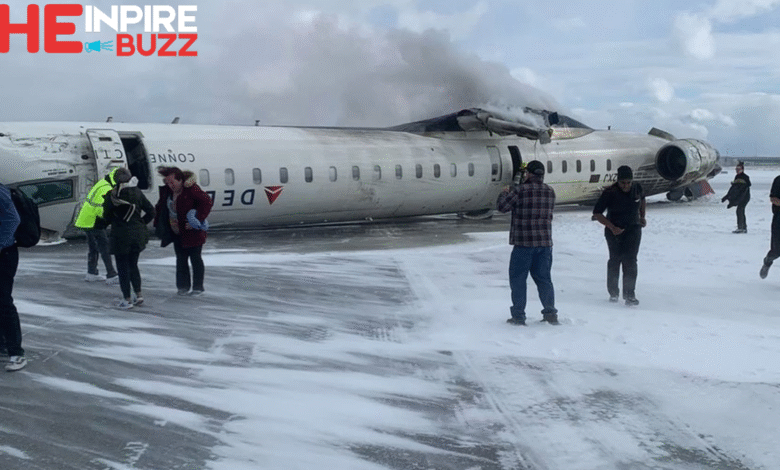Toronto Plane Crash Understanding the Incident and Its Impact

A Toronto plane crash is a phrase that immediately captures attention, often sparking both concern and curiosity. Aviation accidents, especially when they occur in or near major cities, raise questions about safety, preparedness, and the long-term effects on communities. Toronto, being one of the busiest hubs in North America, has seen its share of aviation-related incidents, and each event leaves behind not only stories of survival and loss but also lessons for the future.
Whenever a Toronto plane crash makes the news, it resonates far beyond the city’s borders. Families, aviation experts, and local authorities all play a part in piecing together what happened. The aftermath is not just about the mechanical or technical causes but also about the human experiences tied to it. People want to know how such an event occurred, what safety measures failed, and most importantly, how similar situations can be avoided moving forward.
Toronto Plane Crash What Happened and Why It Matters
The story of a Toronto plane crash is never just about the moment the aircraft came down. It is about the chain of events leading up to it, from weather conditions and technical checks to the performance of the crew on board. Aviation investigators spend months carefully analyzing each detail, aiming to reconstruct the circumstances that led to the incident. This process is crucial because every insight gained has the potential to save lives in the future.
Equally important is the perspective of the community. For Toronto residents, any crash on or near its busy runways is not just a statistic. It’s a lived experience, whether through disrupted travel, emergency sirens in the night, or the heartache of knowing lives were impacted. Such moments are reminders of how interconnected modern travel is with everyday life, and why discussions about aviation safety remain relevant.
Toronto Plane Crash: Safety Concerns and Aviation Response
Every Toronto plane crash raises immediate questions about safety. Airlines, airports, and regulators face increased scrutiny whenever a serious incident occurs. Was the plane maintained properly? Did weather conditions play a role? Were communication lines between the cockpit and air traffic control functioning effectively? These are not just technical details — they are points that determine the level of public trust in the aviation system.
The response after a crash also highlights the city’s readiness. Toronto has some of the most advanced emergency response teams in Canada, and their ability to act quickly often makes the difference between life and death. Firefighters, paramedics, and police all train for scenarios like these, and their coordinated efforts are often commended. However, every incident brings new learning opportunities, pushing authorities to improve their systems further.
Aviation History and Toronto’s Connection
Toronto’s aviation history has always been tied to progress and expansion, but with that comes the reality of risk. Over the decades, Pearson International Airport has grown into a massive hub, connecting millions of travelers across the globe. With such a high volume of traffic, the city has inevitably experienced a handful of tragedies. While rare, they serve as somber reminders that even with the best technology, aviation is not immune to accidents.
The evolution of safety protocols in Toronto is heavily influenced by past incidents. Whenever a plane crash occurs, it sets into motion a series of reforms and updates. These might involve stricter maintenance schedules, better training programs for crews, or improvements in air traffic control technology. In a way, Toronto’s aviation safety measures today stand as the result of both innovation and the lessons learned from past tragedies.
Human Stories Beyond the Headlines
Behind every crash headline are personal stories. For passengers who survive, recounting the events often becomes a life-defining moment. The fear, confusion, and relief of survival are emotions that stay with them forever. Families who lose loved ones, on the other hand, face a different reality, one of unanswered questions and ongoing grief. These human experiences remind us that aviation disasters are not just about technical malfunctions but about people.
Toronto has a strong culture of community support, and after a crash, vigils, memorials, and support services often emerge. Neighbors come together to help affected families, while counseling services are extended to survivors and witnesses. These collective efforts reflect the resilience of a city that stands together in difficult times, proving that even in tragedy, unity prevails.
Media Coverage and Public Reactions

Media plays a central role in shaping how the public perceives a plane crash. In Toronto, every major aviation incident is covered extensively, from breaking news updates to in-depth analysis pieces. While this helps keep people informed, it also stirs emotional responses. The images of wreckage, emergency crews, and grieving families can leave lasting impressions on the public psyche.
At the same time, media coverage often pressures aviation authorities to be more transparent. The demand for answers grows stronger as reporters push for details about what went wrong. This dynamic creates both accountability and tension, as investigators must balance public communication with the careful, time-consuming process of finding the truth.
Lessons Learned from Past Tragedies
Toronto’s aviation history shows that every crash, no matter how small or large, leaves lessons behind. Investigations often reveal gaps that might otherwise go unnoticed. Sometimes it’s a mechanical issue that requires manufacturers to rethink designs. Other times it’s a human factor, like fatigue or miscommunication, that highlights the importance of crew training.
For the city and its residents, the broader lesson is resilience. Toronto has faced tragedies before and has consistently emerged stronger. By remembering the past and applying those lessons, both the aviation industry and the community take steps toward preventing future disasters.
The Role of Technology in Prevention
Modern aviation technology has made flying safer than ever before, but no system is perfect. Toronto, being a hub for international travel, benefits from some of the latest innovations in air traffic control and aircraft safety. Advanced radar systems, improved weather forecasting, and automated safety checks are all tools designed to minimize the risk of a crash.
Still, incidents remind us that technology cannot replace human decision-making entirely. Pilots, engineers, and controllers must all stay sharp, using these tools effectively while being prepared to respond when unexpected situations arise. This balance between human expertise and technological advancement is what keeps aviation moving forward.
The Community’s Path to Healing
Recovery after a crash takes time, not just for the victims but for the community at large. Toronto is known for its resilience, and when tragedy strikes, people often come together in remarkable ways. Memorial services, fundraisers, and awareness campaigns are just some of the ways the city processes collective grief.
Beyond immediate healing, there is also a long-term cultural impact. Crashes change the way people think about travel, even if only for a while. For some, it heightens anxiety, while for others, it deepens appreciation for the professionals who keep flights safe every day.
Conclusion
The phrase Toronto plane crash carries a heavy weight, not because it is common, but because each event tied to it leaves a lasting mark. Whether through loss, survival, or reform, these incidents shape the aviation industry and the community’s relationship with air travel. Toronto, as a global city, continues to face these challenges head-on, always striving to learn and grow from them.



